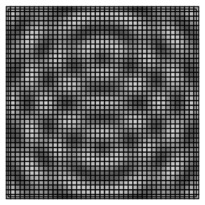En cliquant sur une imagette, vous accéderez au source et à l'image. En cliquant sur cette dernière, vous ouvrirez le fichier PDF associé.







/* -*-ePiX-*- */ // A circular hyperboloid of one sheet and its two families of rulings #include "epix.h" using namespace ePiX; // Uncomment for a shaded hyperboloid; makes the surface more visible, // but the rulings harder to see //#define SHADED // Uncomment to draw three rulings in a slightly different color, for // emphasis #define RULINGS const double MAX(3); // frame size const double MAX2(1.5); // parameter domain size const double temp(sinh(MAX2)); // surface parametrization P hyperboloid(double u, double v) { return cyl(cosh(u), v, sinh(u)); } const int N1(36); // latitudes const int N2(48); // longitudes const int NUM_LINES(64); // # of rulings; should be a multiple of 4 const P LIGHT(1,1,0.5); // location of light, for shading const P VIEWPT(20, 0.5, 5); const double EPS(0.0); //0.025; // shrinkage const double du(2*MAX2/N1); const double dv(1.0/N2); // colors of rulings void plus_color(void) { #ifdef RULINGS rgb(0.9,0.6,0); #else red(); #endif } void minus_color(void) { #ifdef RULINGS rgb(0.1,0.6,0.9); #else rgb(0,0.5,1); #endif } // draw a ruling, truncating at the plane x=0 // (x,y,z) = (cos(th), sin(th), 0) + t*(-/+sin(t), +/-cos(t), 1) void l_plus(double t) { double t_min(-temp), t_max(temp); if (Cos(t) - t_max*Sin(t) < 0) t_max = Cot(t); if (Cos(t) - t_min*Sin(t) < 0) t_min = Cot(t); line(P(Cos(t) - t_max*Sin(t), Sin(t) + t_max*Cos(t), t_max), P(Cos(t) - t_min*Sin(t), Sin(t) + t_min*Cos(t), t_min)); } void l_minus(double t) { double t_min(-temp), t_max(temp); if (Cos(t) + t_max*Sin(t) < 0) t_max = -Cot(t); if (Cos(t) + t_min*Sin(t) < 0) t_min = -Cot(t); line(P(Cos(t)+t_max*Sin(t), Sin(t)-t_max*Cos(t), t_max), P(Cos(t)+t_min*Sin(t), Sin(t)-t_min*Cos(t), t_min)); } // generalities class element { private: P pt1, pt2, pt3, pt4; double distance; public: element() : distance(camera.get_range()) { } element(P f(double u, double v), double u0, double v0) : pt1(f(u0+EPS,v0+EPS)), pt2(f(u0+du-EPS,v0+EPS)), pt3(f(u0+du-EPS,v0+dv-EPS)), pt4(f(u0+EPS,v0+dv-EPS)) { P center(0.25*(pt1 + pt2 + pt3 + pt4)); P temp(camera.get_viewpt()); distance = norm(center-temp); } double how_far() const { return distance; } void draw() const { P normal((pt2 - pt1)*(pt4 - pt1)); normal *= 1/norm(normal); #ifdef SHADED double dens(0.75*(1-pow(normal|LIGHT, 2)/(LIGHT|LIGHT))); gray(dens); #endif ePiX::quad(pt1, pt2, pt3, pt4); } }; class By_distance { public: bool operator() (const element& arg1, const element& arg2) { return arg1.how_far() > arg2.how_far(); } }; int main() { bounding_box(P(-MAX,-MAX), P(MAX,MAX)); unitlength("1in"); picture(6,6); begin(); revolutions(); fill(); crop(); // use constant dark-gray shading if no shading requested #ifndef SHADED gray(0.8); #endif viewpoint(VIEWPT); std::vector<element> mesh(0); for (int i=0; i<N1; ++i) for (int j=0; j<N2; ++j) mesh.push_back(element(hyperboloid, -MAX2+du*i, dv*j)); sort(mesh.begin(), mesh.end(), By_distance()); for (unsigned int i=0; i<mesh.size(); ++i) mesh.at(i).draw(); fill(false); bold(); // hard-coded colors rgb(0,0.5,1); for (int i=-0.5*NUM_LINES; i <= 0.5*NUM_LINES; ++i) l_minus(i*1.0/NUM_LINES); red(); for (int i=-0.5*NUM_LINES; i <= 0.5*NUM_LINES; ++i) l_plus(i*1.0/NUM_LINES); #ifndef RULINGS pen(2); #else pen(1.5); #endif minus_color(); line(P(1,0,0)-P(0,-temp,temp),P(1,0,0)+P(0,-temp,temp)); label(P(1,0,0)-P(0,-temp,temp), P(2,-2), "$\\ell_0^-$", br); font_size("footnotesize"); label(P(0,0,-1.5*temp), P(0,-24), "$\\ell_\\theta^-(t)=(\\cos\\theta, \\sin\\theta, 0) + t(\\sin\\theta, -\\cos\\theta, 1)$", b); font_size(); plus_color(); line(P(1,0,0)-P(0, temp,temp),P(1,0,0)+P(0, temp,temp)); label(P(1,0,0)+P(0, temp,temp), P(18,2), "$\\ell_0^+$", t); line(P(0,1,0)-P(-temp,0,temp), P(0,1,0)); label(P(0,1,0)-P(-temp,0,temp), P(0,-4), "$\\ell_{\\pi/2}^+$",b); font_size("footnotesize"); label(P(0,0,-1.5*temp), P(0,-12), "$\\ell_\\theta^+(t)=(\\cos\\theta, \\sin\\theta, 0) + t(-\\sin\\theta, \\cos\\theta, 1)$", b); end(); }











